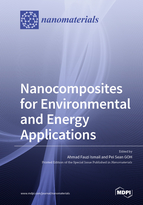Nanocomposites for Environmental and Energy Applications
A special issue of Nanomaterials (ISSN 2079-4991).
Deadline for manuscript submissions: closed (31 March 2019) | Viewed by 43345
Special Issue Editors
Interests: membrane technology; nanostructured materials; hemodialysis; reverse osmosis; fuel cell; nanofiltration; ultrafiltration
Special Issues, Collections and Topics in MDPI journals
Interests: nanomaterial and nanocomposite synthesis; surface modification; polymeric nanocomposite; membranes; desalination and wastewater treatment; energy production
Special Issues, Collections and Topics in MDPI journals
Special Issue Information
Dear Colleagues,
Environmental and energy issues are the two major problems that our world is facing today. The establishment of sustainable and innovative solutions are needed to address the emerging problems. Functional nanocomposites are emerging materials that have become important due to their astonishing chemical and physical properties. The synergy effects rendered by a wide spectrum of nanomaterials and host materials have shown unlimited potential and advantages in many practical applications. Specifically, various nanocomposites are known to serve as sustainable solutions to curb global issues that are related to environmental pollution and energy shortage. This Special Issue of Nanomaterials, “Nanocomposites for Environmental and Energy Applications”, aims at collecting a compilation of articles, which cover research articles, reviews and communications, with topics areas focused on the development of the state-of-the-art nanocomposites to tackle environment and energy related issues.
Prof. Ahmad Fauzi Ismail
Dr. Goh Pei Sean
Guest Editors
Manuscript Submission Information
Manuscripts should be submitted online at www.mdpi.com by registering and logging in to this website. Once you are registered, click here to go to the submission form. Manuscripts can be submitted until the deadline. All submissions that pass pre-check are peer-reviewed. Accepted papers will be published continuously in the journal (as soon as accepted) and will be listed together on the special issue website. Research articles, review articles as well as short communications are invited. For planned papers, a title and short abstract (about 100 words) can be sent to the Editorial Office for announcement on this website.
Submitted manuscripts should not have been published previously, nor be under consideration for publication elsewhere (except conference proceedings papers). All manuscripts are thoroughly refereed through a single-blind peer-review process. A guide for authors and other relevant information for submission of manuscripts is available on the Instructions for Authors page. Nanomaterials is an international peer-reviewed open access semimonthly journal published by MDPI.
Please visit the Instructions for Authors page before submitting a manuscript. The Article Processing Charge (APC) for publication in this open access journal is 2900 CHF (Swiss Francs). Submitted papers should be well formatted and use good English. Authors may use MDPI's English editing service prior to publication or during author revisions.
Keywords
- nanomaterials
- nanocomposites
- synthesis
- functionalization
- environment
- energy
- wastewater
- desalination
- fuel cell








